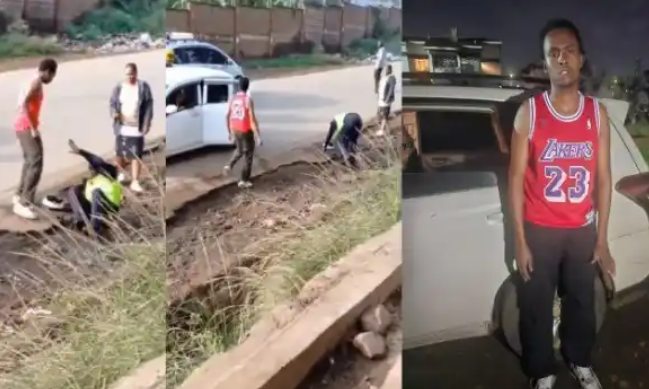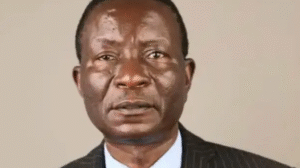Kenyans have been gripped by a viral video showing a driver assaulting a police officer, sparking widespread outrage and questions about the underlying causes of such brazen behavior.
As new details emerge, the situation becomes increasingly complex, shedding light on broader issues within the Kenyan criminal justice system and societal interactions with law enforcement.
The driver in question, identified as Njoroge, has been revealed as a gang leader with a substantial criminal history.
According to a reputable source, Njoroge has ten pending cases against him, marking him as a notable figure in criminal activities in his area.
The incident, captured vividly on camera, showed Njoroge attempting to hit the police officer with a sword before ultimately attacking him with kicks after being chased down.
Njoroge’s confession adds a critical dimension to the narrative. He admitted to assaulting the officer out of frustration after allegedly being asked for a significant bribe, which he could not afford.
This revelation points to a potential systemic issue of corruption within the police force, a problem that has long plagued Kenyan society.
The perceived need to resort to violence when faced with extortionate demands from law enforcement officers indicates deep-seated distrust and frustration among citizens.
The arrest of Njoroge came after detectives tracked him to his home in Kayole. He was subsequently detained and taken to a police station, where investigations continue.
Authorities are keen on understanding the full context of the assault and the broader implications it may have for law enforcement and public safety.
This incident is part of a troubling pattern of violence against police officers in Kenya.
It highlights a reciprocal cycle of violence and mistrust between the public and law enforcement. Instances of police officers being attacked are not isolated.
Moreover, the public has frequently accused police officers of using excessive force and engaging in corrupt practices, further eroding their credibility.
Some police officers have been implicated in aiding and abetting criminals. For instance, at Kiamaciri Police Station, two officers were arrested for allegedly assisting a Ugandan suspect in escaping custody.
Such cases exacerbate the perception of a deeply flawed and compromised police force.
The dual narratives of police brutality and public violence against officers underscore a critical need for reform within the Kenyan police force. Addressing corruption, enhancing accountability, and rebuilding trust between the police and the communities they serve are imperative.
The government must prioritize these reforms to prevent further escalation of tensions and ensure the safety and security of both citizens and law enforcement officers.
The case of Njoroge is not just an isolated incident of a gang leader lashing out but a symptom of larger systemic issues within Kenya’s law enforcement framework.
It highlights the urgent need for comprehensive reforms to address corruption, rebuild trust, and ensure that both police officers and the public can coexist peacefully and safely.





















Add Comment